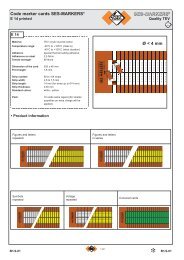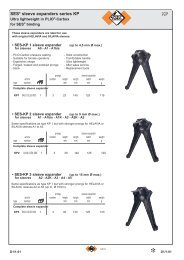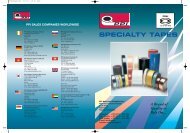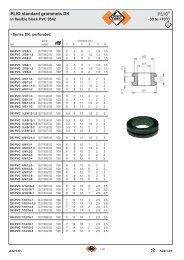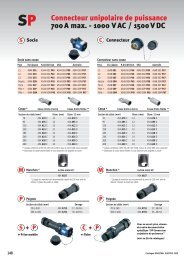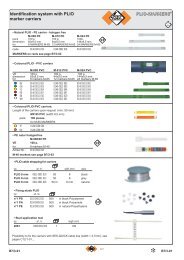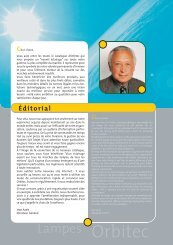orbitec - Palissy Galvani
orbitec - Palissy Galvani
orbitec - Palissy Galvani
You also want an ePaper? Increase the reach of your titles
YUMPU automatically turns print PDFs into web optimized ePapers that Google loves.
Discharge lamps<br />
The performance of<br />
the metal halide lamp<br />
The performance of the metal halide lamp is<br />
remarkable:<br />
• Extremely good lighting power (60 to 120 lm/W).<br />
• An average lifespan of 10,000 hours.<br />
• A light spectrum close to real light (daylight).<br />
The range of metal halide lamps is very extensive<br />
according to the following three parameters:<br />
• Colour temperature (2000°K to 6000°K).<br />
• Lighting power (50 à 150 lm/W).<br />
• Colour quality (20 < Ra < 95).<br />
Considering the range of possibilities provided by<br />
their features, it is necessary to establish a compromise<br />
tailored to the use requirements. The user’s choice<br />
will take into account three parameters to the<br />
detriment of the others.<br />
Low and high pressure<br />
discharge lamps with<br />
sodium gas<br />
• Constitution<br />
The principle of sodium lamps is that of metal halide<br />
lamps and mercury lamps. The burner contains<br />
sodium.<br />
The light produced by these lamps is orangey-yellow<br />
and deforms colours perceived by the human eye. To<br />
make up for the poor colour quality, the solution is to<br />
increase pressure of the gas. However, when under<br />
high pressure, sodium gas attacks the quartz on the<br />
burner and the lamp does not resist these attacks.<br />
The first generation sodium gas discharge lamp was<br />
therefore “low pressure”, to avoid the sodium rapidly<br />
destroying the lamp.<br />
Technological progress has enabled manufacturers to<br />
produce a “high pressure” lamp with an alumina<br />
burner resistant to very high temperatures and<br />
attacks by sodium gas. The second generation of<br />
discharge lamps produces better colour quality than<br />
“low pressure” lamps.<br />
The sodium lamp is recognised for its very good lighting<br />
power. We can have a good light, even with fog.<br />
That’s why it is used for road and street lamps.<br />
High pressure discharge<br />
lamps with mercury gas<br />
• Constitution and operation<br />
The operating principle is the same as metal halide<br />
lamps.<br />
For mercury lamps, lighting power and homogeneity<br />
of the light are favoured with regard to colour quality<br />
(mediocre). The light given off is very white.<br />
• A variant: the combined lamp<br />
Combined lamps are mercury lamps containing a<br />
filament. This filament allows preheating of the burner<br />
and gives the light given off by the lamp a slightly<br />
warmer shade. When the lamp is connected, the<br />
filament positioned around the burner becomes<br />
incandescent and heats the quartz envelope until the<br />
mercury evaporates. The mercury gas favours the<br />
passage of electrons between the two electrodes and<br />
the lamp is thus lit. The orangey-red colour of the<br />
incandescent filament allows gives the lamp a better<br />
colour quality.<br />
Combined lamps have the advantage of being used<br />
directly without a lighting system, but the presence<br />
of a filament makes them fragile.<br />
What you need to know<br />
The use of mercury lamps requires a lighting<br />
system (except for combined lamps).



